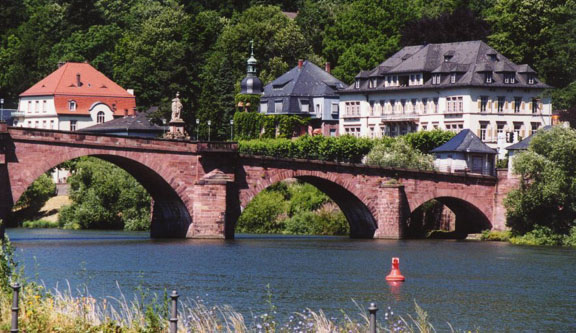

Heidelberg

stone bridge (1786 - 1788)
Heidelberg (Germany), city in southwestern Germany, in Baden-Württemberg, on the Neckar River, near Mannheim. Noted for its lovely setting, the city is a manufacturing, transportation, tourist, and cultural center. Products include printing presses, electrical equipment, leather goods, and textiles. Several important scientific research institutes are in Heidelberg.
Academy of Science with ruins of castle above
On the summit of Jettenbühl (195 m/640 ft), which dominates the eastern portion of the city, is Heidelberg Castle (mainly 14th-17th century), one of the most impressive historic landmarks of Germany.
Renaissance wing of ruined castle
Baroque wing
Gothic window on the oldest part of the castle
The structure, now largely in ruins, preserves numerous examples of medieval, Renaissance, and baroque German architecture. Of particular interest are the four granite columns located in the castle courtyard, which were once part of a castle belonging to Charlemagne. The castle's Otto Heinrich wing houses a pharmaceutical museum. The cellar of Heidelberg Castle contains the famed Heidelberg Tun, a wine vat with a capacity of 220,017 liters (58,124 gallons).
Fredrick
Noteworthy religious buildings of Heidelberg are the 15th-century Church of Saint Peter, on the door of which the Bohemian theologian and martyr Jerome of Prague nailed his celebrated theses criticizing the papacy; and the Church of the Holy Ghost, also dating from the 15th century. The famous Old Bridge was once the medieval city's main gate. To a considerable extent, the world renown of the city is derived from the presence of the University of Heidelberg (1386), the first university in Germany.
in this town even the elves have a web site
First mentioned in the 12th century, Heidelberg was, until 1720, the capital of the Palatinate. During the Reformation the city was one of the chief strongholds of German Protestantism.
giant tower of the castle destroyed by the French
French troops sacked the town during the Thirty Years' War (1618-1648). In 1689 and 1693, Heidelberg was further damaged by invading French troops. Following World War II (1939-1945) the city became the headquarters for United States forces in Europe. Population (1990 estimate) 135,800.
![]()
University of Heidelberg
the Red Ox a traditional student hangout in town
entrance to the administration building
the Aula (formal meeting room)
The Karzer (Student's Dungeon)
It served from 1712 to 1914 as a prison for students, over whom the university administration had legal sovereignty. The judicial authorities of the town could not punish violations of public order. Usual violations were: drunkenness, disturbing the nighttime peace, gross misbehavior, chasing citizens' pigs and their squeaking piglets through the alleys, extinguishing street lamps. When the 'Amtmann' (policeman) was teased, insulted or resistance was offered against him it often went to four weeks - the 'Amtmann' represented the State.
student prison room
There was no water in the prison flat. It had to be fetched from the well in the courtyard. There was also no kitchen. For the first two days delinquents were starved on dry bread and water. Later on they were allowed to have meals sent from the outside, from restaurants, landladies or friends. Alcohol was not prohibited. Prisoners could visit each other in 'their' cells, receive visits from outside and even follow lectures, as there was a door to the University. There were five cells with hard iron beds and straw mattresses, two tables in each room and a few stools. Many prisoners engraved their names in the wood. To kill time they played cards and decorated the ceilings of the rooms and also the entrance staircase.
In those days nearly all students were a member of some variety of a fraternity, wearing different colors, a uniform, special hats and ribbons. Many of them were hostile towards each other. Unauthorized duels were also sentenced with imprisonment. The black color of the ceiling paintings is candle-soot, for the walls students used soot of the small iron stoves. This is now protected over with varnish. Other watercolors were brought in from outside. Some students left their photos imbedded in the doors of the rooms when they left. The rooms were all baptized with names like Sansouci -after the Prussian Palace in Potsdam, Grand Hotel, Palais Royal. The bathroom was named Royal Throne.
Royal Throne
![]()
![]()